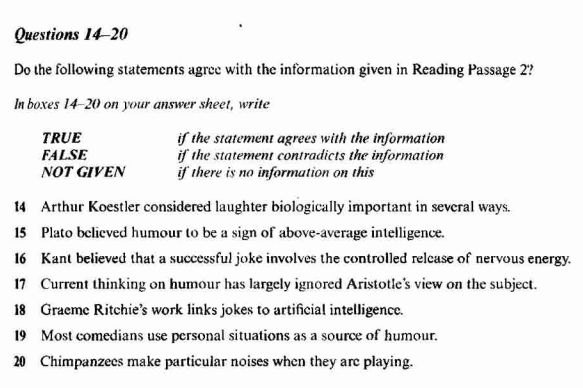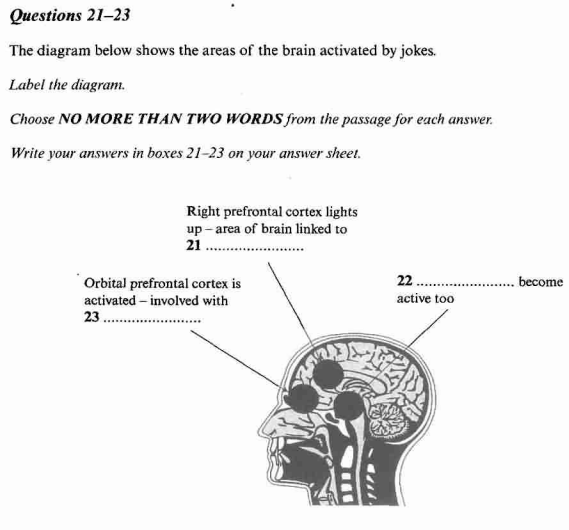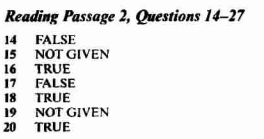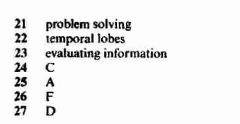剑桥雅思5:Test2雅思阅读PASSAGE 2真题+答案+解析
发布时间:2020-09-24 关键词:剑桥雅思5:Test2雅思阅读PASSAGE 2真题+答案+解析为了帮助大家在雅思考试中取得的成绩,下面新航道小编为大家整理出关于剑桥雅思5:Test2雅思阅读PASSAGE 2真题+答案+解析,大家可以多加练习。
READING PASSAGE 2
You should spend about 20 minutes on Questions 14- 27. which are based on Reading Passage 2below.
What's so funny?
John McCrone reviews recent research on humour
The joke comes over the headphones: 'Which side of a dog has the most hair? The left.'No, not funny. Try again. 'Which side of a dog has the most hair? The outside.' Hah! Thepunchline is silly yet fitting, tempting a smile, even a laugh, Laughter has always struckpeople as deeply mysterious, perhaps pointless. The writer Arthur Koestler dubbed it theluxury reflex: 'unique in that it serves no apparent biological purpose'.
Theories about humour have an ancient pedigree. Plato expressed the idea that humour issimply a delighted feeling of superiority over others, Kant and Freud felt that joke-tellingrelies on building up a psychic tension which is safely punctured by the ludicrousness ofthe punchline. But most modern humour theorists have settled on some version of
Aristotle's belief that jokes are based on a reaction to or resolution of incongruity, when thepunchline is either a nonsense or, though appearing silly, has a clever second meaning.
Graeme Ritchie, a computational linguist in Edinburgh, studies the linguistic structure ofjokes in order to understand not only humour but language understanding and reasoningin machines. He says that while there is no single format for jokes, many revolve around asudden and surprising conceptual shift. A comedian will present a situation followed by anunexpected interpretation that is also apt.
So even if a punchline sounds silly, the listener can see there is a clever semantic fit andthat sudden mental 'Aha!' is the buzz that makes us laugh. Viewed from this angle, humouris just a form of creative insight, a sudden leap to a new perspective.
However, there is another type of laughter, the laughter of social appeasement and it isimportant to understand this too, Play is a crucial part of development in most young
mammals. Rats produce ultrasonic squeaks to prevent their scuffles turning nasty.
Chimpanzees have a 'play-face' - a gaping expression accompanied by a panting ah, ah'noise. In humans, these signals have mutated into smiles and laughs. Researchers believesocial situations, rather than cognitive events such as jokes, trigger these instinctual
markers of play or appeasement. People laugh on fairground rides or when tickled to flag aplay situation, whether they feel amused or not.
Both social and cognitive types of laughter tap into the same expressive machinery in ourbrains, the emotion and motor circuits that produce smiles and excited vocalisations.
However, if cognitive laughter is the product of more general thought processes, it shouldresult from more expansive brain activity.
Psychologist Vinod Goel investigated humour using the new technique of 'single event'functional magnetic resonance imaging (fMR). An MRI scanner uses magnetic fields andradio waves to track the changes in oxygenated blood that accompany mental activity.
Until recently, MRI scanners needed several minutes of activity and so could not be used totrack rapid thought processes such as comprehending a joke. New developments now
allow half-second 'snapshots" of all sorts of reasoning and problem-solving activities.
Although Goel felt being inside a brain scanner was hardly the ideal place for appreciatinga joke, he found evidence that understanding a joke involves a widespread mental shift. Hisscans showed that at the beginning of a joke the listener's prefrontal cortex lit up,
particularly the right prefrontal believed to be critical for problem solving. But there wasalso activity in the temporal lobes at the side of the head (consistent with attempts to rousestored knowledge) and in many other brain areas. Then when the punchline arrived, a newarea sprang to life - the orbital prefrontal cortex. This patch of brain tucked behind the
orbits of the eyes is associated with evaluating information.
Making a rapid emotional assessment of the events of the moment is an extremely
demanding job for the brain, animal or human. Energy and arousal levels may need to beretuned in the blink of an eye. These abrupt changes will produce either positive or
negative feelings. The orbital cortex, the region that becomes active in Goel's experiment,seems the best candidate for the site that feeds such feelings into higher-level thoughtprocesses, with its close connections to the brain's sub-cortical arousal apparatus andcentres of metabolic control.
All warm-blooded animals make constant tiny adjustments in arousal in response to
external events, but humans, who have developed a much more complicated internal lifeas a result of language, respond emotionally not only to their surroundings, but to theirown thoughts. Whenever a sought-for answer snaps into place, there is a shudder ofpleased recognition. Creative discovery being pleasurable, humans have learned to findways of milking this natural response. The fact that jokes tap into our general evaluativemachinery explains why the line between funny and disgusting, or funny and frightening,can be so fine. Whether a joke gives pleasure or pain depends on a person's outlook.
Humour may be a luxury, but the mechanism behind it is no evolutionary accident. AsPeter Derks, a psychologist at William and Mary College in Virginia, says: 'I like to think ofhumour as the distorted mirror of the mind. It's creative, perceptual, analytical and lingual.If we can figure out how the mind processes humour, then we'll have a pretty g00d handleon how it works in general.'
剑桥雅思5Test2雅思阅读Pessage2译文:What’s so funny?
什么事这么好笑?
John McCrone回顾了最近关于幽默的研究
耳机里传来了一个笑话:“狗狗哪一边的毛最多?”左边。“不,不是有趣的。再试一次。“狗的哪一边的毛最多?”外面的。“哈!笑点很傻却很合适,诱人的微笑,甚至是大笑,笑总是让人觉得深深的神秘,也许毫无意义。作家亚瑟·凯斯特勒(Arthur Koestler)将其称为“鲁苏里反射”(uxury reflex):“它的独特之处在于它没有明显的生物学意义。”
有关幽默的理论源远流长。柏拉图认为,幽默仅仅是一种高高在上的愉悦感。康德和弗洛伊德认为,讲笑话依赖于建立一种精神紧张,而这种紧张会被笑点的滑稽性安全戳穿。但大多数现代幽默理论家已经确定了某种版本的幽默
亚里士多德认为笑话是基于对不协调的反应或解决,当笑点要么是无意义的,要么虽然看起来很傻,却有另一种聪明的含义。
Graeme Ritchie是爱丁堡的一位计算语言学家,他研究笑话的语言结构不仅是为了理解幽默,还为了理解机器的语言理解和推理。他说,虽然笑话没有单一的形式,但笑话都围绕着一个突然的、令人惊讶的观念转变。一个喜剧演员会在呈现一种情况之后给出一个意料之外的、同样恰当的解释。
因此,即使一个笑点听起来很傻,听者也能看出其中有一个聪明的语义契合,而且他们会突然意识到“啊哈!是让我们开怀大笑的嗡嗡声。从这个角度来看,幽默只是一种创造性的洞察力,一种对新视角的突然飞跃。
然而,还有另一种笑声,社交缓和的笑声,理解这一点也很重要,玩耍在大多数年轻人的成长中是至关重要的一部分
哺乳动物。老鼠会发出超声波般的吱吱声,以防止它们之间的扭打变得糟糕。
黑猩猩有一张“游戏脸”——张着嘴的表情伴随着“啊,啊”的喘气声。在人类中,这些信号已经变异为微笑和大笑。研究人员认为,触发这种本能的是一些社交场合,而不是笑话等认知事件
游戏或绥靖的标记。人们在游乐场的游乐设施上或者被挠痒痒的时候都会大笑,不管他们是否觉得开心。
社交型和认知型的笑都利用了我们大脑中相同的表达机制,即产生微笑和兴奋发声的情感和运动回路。
然而,如果认知笑是更普遍的思维过程的产物,那么它应该是更广泛的大脑活动的产物。
心理学家维诺德·戈埃尔使用“单事件”功能磁共振成像(fMR)的新技术研究了幽默。核磁共振扫描仪使用磁场和无线电波来跟踪伴随大脑活动的含氧血液的变化。
直到最近,核磁共振扫描仪需要几分钟的活动,因此不能用于跟踪思维过程,如理解一个笑话。现在的新发展
允许对各种推理和解决问题的活动进行半秒钟的“快照”。
尽管戈埃尔觉得身处脑部扫描仪中并不是欣赏一个笑话的理想场所,但他发现有证据表明理解一个笑话涉及到广泛的精神转变。他的扫描显示,在笑话开始时,听众的前额叶皮层会活跃起来,
尤其是右前额叶被认为是解决问题的关键。但在大脑一侧的颞叶(与收集储存知识的尝试相一致)和大脑的许多其他区域也有活动。当笑点到来时,一个新的区域突然活跃起来——眶前额叶皮层。大脑的这片区域隐藏在
眼睛的轨道与评估信息有关。
对当时的事件做出的情绪评估是极其困难的
对于大脑,动物或人类来说,这是一项艰巨的任务。在一眨眼的时间里,能量和兴奋水平可能需要被调整。这些突然的变化将产生正面或负面的影响
负面情绪。在戈埃尔的实验中活跃起来的眶皮层,似乎是将这种感觉输入思维过程的候选区域,因为它与大脑皮层下的唤醒装置和代谢控制中心有着密切的联系。
所有的温血动物都会不断地对刺激做出微小的调整
但是,由于语言的作用,人类的内部生活变得复杂得多,人类不仅对周围的环境作出情感上的反应,而且对自己的思想作出情感上的反应。每当一个梦寐以求的答案突然出现时,人们就会为得到认可而高兴得发抖。创造性的发现是愉快的,人类已经学会了
我们先来看下题目:



剑桥雅思5Test2阅读Passage2题目+答案解析


Question 14
答案:FALSE
关键词:Arthur Koestler
定位原文: 第1段最后1句“The writer….”
解题思路: 文中已经明确指出“笑的独特之处就在干它没有明显的生物学目的”,而题目却要说它从生物学的方面而言都很重要,本题是抵触型的False。
Question 15
答案:NOT GIVEN
关键词: Plato
定位原文: 第2段第2句“Plato expressed…”
解题思路: 这句话应该翻译为“柏拉图认为幽默是因感觉比别人优越而体会到的快乐感觉”而并没有具体提到在哪方面比别人优越。题目将这个范围缩小到了在智力上比别人优越,明显是一道完全未提及型的NOT GIVEN。
Question 16
答案: TRUE
关键词:Kant
定位原文: 第2段第3句“Kant and Freud felt…”
解题思路: 康德和弗洛伊德认为讲笑话时需要营造一种精神上的紧张气氛,最后抖开笑话的包袱,让其滑稽有趣之处化解这种紧张气氛。tension 等同于energy,safely punctured 等同于controlled release。本题是一道典型的同义词对应型的TRUE。
Question 17
答案:FALSE
关键词:Aristotle
定位原文: 第2段最后1句“But most modem humour…”
解题思路: 但是大多数当代幽默理论家最终都采纳了类似亚里士多德的观点……settle on决定;选定,题目中的ignore就和这个词组抵触,反义词抵触型FALSE。
Question 18
答案:TRUE
关键词:Graeme Ritchie
定位原文: 第3段第1句“Graeme Ritchie,…, studies the linguistic…”
解题思路: Graeme Ritchie在研究笑话的语言结构,不仅为了理解幽默,同时也为了了解机器的语言理解能力及推理能力。此题的关键是理解artificial intelligence 一词。所谓A.I.,其实就是指机器可以具有理解语言和逻辑推理的能力。
Question 19
答案:NOT GIVEN
关键词:comedians
定位原文: 第3段最后1句话“A comedian will present a…”
解题思路: 喜剧演员会描述一个情景,然后给出一个出人意料却又恰如其分的解释。这里并未提到喜剧演员是否会将个人情景作为笑料。
Question 20
答案: TRUE
关键词:chimpanzees
定位原文: 第5段第4句“Chimpanzees have a…”
解题思路: 黑狸猩有一种游戏表情,把嘴张得大大的,同时发出“啊、啊”的喘息声。文中这句话正好表明了黑猩猩在玩耍的时候会发出某种声音,与题目一致,故选择TRUE。
Question 21
答案: problem solving
关键词: area/ activated/ right prefrontal/orbital prefrontal
定位原文: 第8段第2句“...listener’s prefrontal cortex Lit up, particularly the right prefrontal…”
解题思路: 问题要求填出right prefrontal cortex与何种思维活动有关,所以答案为problem solving。
Question 22
答案: temporal lobes
关键词:too
定位原文: 第8段第3句
解题思路: 题目中的active对应文中的activity。当然,实际上这道题目只要能将题目中的too和文章中的also相对应就能解出来了。答案是temporal lobes。
Question 23
答案: evaluating information
关键词: orbital prefrontal cortex
定位原文: 第8段最后两句
解题思路: 题目中的involved with相当于文章中的associated with,所以答案应该选择evaluating information。
Question 24
答案: C
关键词: brain / most difficult
定位原文: 第9段第1句
解题思路: 其中extremely demanding就相当于24题中的most difficult,而a rapid emotional assessment就等同于respond instantly to。
Question 25
答案: A
关键词:language
定位原文: 第10段第1句 “..., but humans, who have developed a much…”
解题思路: 定位句正好和A选项相呼应
Question 26
答案: F
关键词: individual
定位原文: 第10段最后1句
解题思路: outlook指“观念,观点”,等同于F答案中的subjective views 。
Question 27
答案:D
关键词: Peter Derks
定位原文:第11段最后1句
解题思路:mind等同于答案D中的brain, works则等同于operation 。




